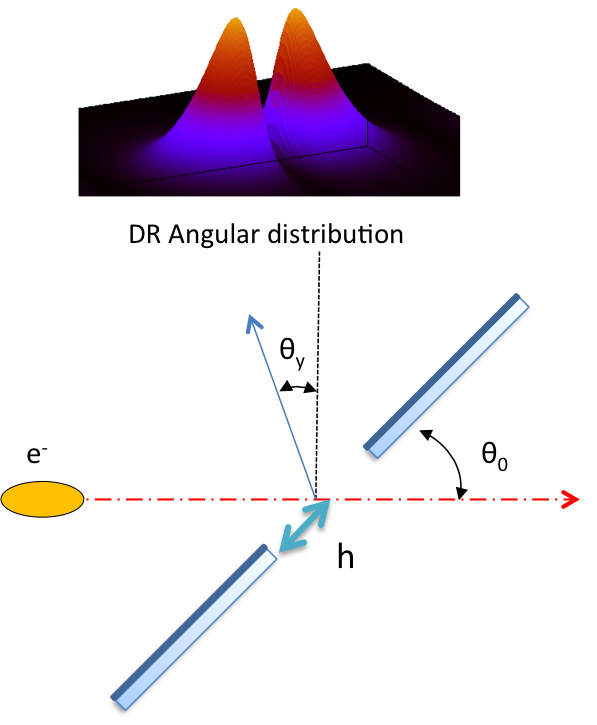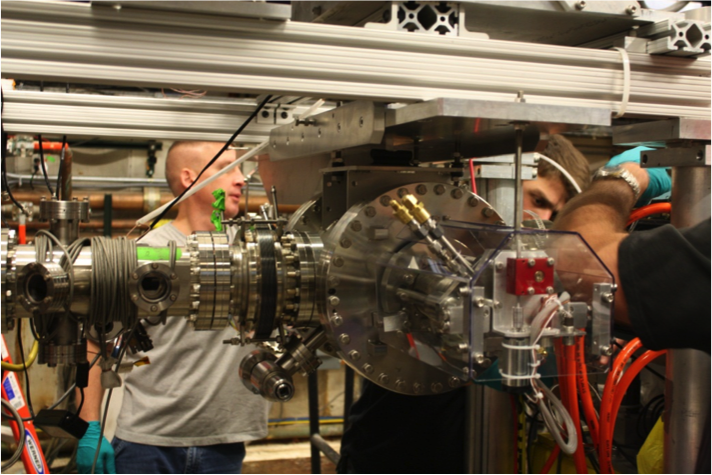Diffraction Radiation Beam Size Monitor

Diffraction radiation (DR) is produced when a relativistic charged particle moves in the vicinity of a
medium. The electric field of the charged particle polarises the target atoms which then oscillate,
emitting radiation with a very broad spectrum. The spatial-spectral properties of DR are sensitive to a
range of electron beam parameters. Furthermore, the energy loss due to DR is so small that the
electron beam parameters are unchanged. DR can therefore be used to develop non-invasive
diagnostic tools. To achieve the micron-scale resolution required to measure the transverse (vertical)
beam size using incoherent DR in CLIC, DR in UV and X-ray spectral-range must be investigated.

Experimental validation of such a scheme is ongoing at CesrTA.
The "medium" in the CesrTA experiment, is a thin silicon wafer. The beam is made to pass through a slit in the wafer so that diffraction radiation is generated by both edges. The slit with a width of about 0.5 mm, is etched in the silicon. One of the challenging aspects of the experiment is to steer the beam through the very small aperture.

A special vacuum chamber with motorized arm for inserting the fork into the beam was built at CERN and installed in CesrTA. The chamber is instrumented with a camera to observe the diffraction radiation.
 Diffraction radiation (DR) is produced when a relativistic charged particle moves in the vicinity of a
medium. The electric field of the charged particle polarises the target atoms which then oscillate,
emitting radiation with a very broad spectrum. The spatial-spectral properties of DR are sensitive to a
range of electron beam parameters. Furthermore, the energy loss due to DR is so small that the
electron beam parameters are unchanged. DR can therefore be used to develop non-invasive
diagnostic tools. To achieve the micron-scale resolution required to measure the transverse (vertical)
beam size using incoherent DR in CLIC, DR in UV and X-ray spectral-range must be investigated.
Diffraction radiation (DR) is produced when a relativistic charged particle moves in the vicinity of a
medium. The electric field of the charged particle polarises the target atoms which then oscillate,
emitting radiation with a very broad spectrum. The spatial-spectral properties of DR are sensitive to a
range of electron beam parameters. Furthermore, the energy loss due to DR is so small that the
electron beam parameters are unchanged. DR can therefore be used to develop non-invasive
diagnostic tools. To achieve the micron-scale resolution required to measure the transverse (vertical)
beam size using incoherent DR in CLIC, DR in UV and X-ray spectral-range must be investigated.
 Experimental validation of such a scheme is ongoing at CesrTA.
The "medium" in the CesrTA experiment, is a thin silicon wafer. The beam is made to pass through a slit in the wafer so that diffraction radiation is generated by both edges. The slit with a width of about 0.5 mm, is etched in the silicon. One of the challenging aspects of the experiment is to steer the beam through the very small aperture.
Experimental validation of such a scheme is ongoing at CesrTA.
The "medium" in the CesrTA experiment, is a thin silicon wafer. The beam is made to pass through a slit in the wafer so that diffraction radiation is generated by both edges. The slit with a width of about 0.5 mm, is etched in the silicon. One of the challenging aspects of the experiment is to steer the beam through the very small aperture.
 A special vacuum chamber with motorized arm for inserting the fork into the beam was built at CERN and installed in CesrTA. The chamber is instrumented with a camera to observe the diffraction radiation.
A special vacuum chamber with motorized arm for inserting the fork into the beam was built at CERN and installed in CesrTA. The chamber is instrumented with a camera to observe the diffraction radiation.
